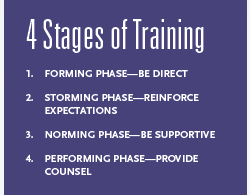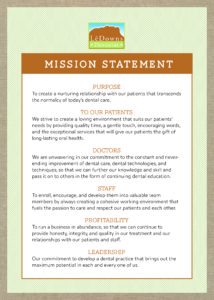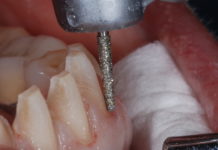Tips for Effective Leadership in Your Practice.
Recently, I conducted a seminar on leadership for six dental practices. During an exercise, we created a flowchart, diagramming the process of the new patient experience—how they are greeted, how are they brought back, what the examination includes (the diagnostic appointment), how treatment is presented, and finally, how and when the financial arrangement is made.
For this exercise, I assigned each participant into a small group. I mixed up the groups because I didn’t want people from the same office sitting together—they needed to get out of their comfort zones. The assignment was to create the flowchart in a certain amount of time. I explained that there was a dentist and a leader at each table, but I didn’t say who was the leader. It was interesting to see how some of the doctors led and some didn’t.
The German philosopher Friedrich Nietzsche (1844–1900) said, “Out of chaos comes order,” so I figured that with the exercise, anything could happen. I watched some hygienists step up and lead, as well as some front office people. At those tables, the human resources (H.R.) people and the dentists sat back and just went along for the ride.
When a dentist doesn’t take a leadership role, he or she is relegated to procedures that may not be what the dentist envisions or even wants for the practice. Active leadership is more than going along with the group—it is purposefully setting the direction for your practice. The difficulty with leadership is that there is not necessarily a “cookie-cutter” way to lead. Each dentist should analyze his or her particular weaknesses and strengths to determine what kind of leadership is required in certain situations.
Coming out of dental school, many dentists don’t know how to lead. Leadership or management of any kind isn’t something taught in school. The most common default for dentists is to manage their team with a dictatorial “my-way-or-the-highway” approach. For most practices with a dictator at the head of the organization, turnover is a huge problem.

As I’ve mentioned previously (see my article, “Goodbye, Gremlins!” Aesthetic Dentistry, Winter 2015), I’ve learned valuable insights from author Ken Blanchard (The One Minute Manager, 1982). Blanchard, along with professor, scientist, and author Dr. Paul Hersey, developed the original theory of Situational Leadership®.
Situational Leadership®
According to The Center for Leadership Studies (The Global Home of Situational Leadership®), “Situational leadership® . . . stresses flexibility and simplicity in execution.” In other words, the leadership style required depends entirely on the demands of each unique situation. The most successful leaders adapt to the needs of the task at hand.
My personal leadership style draws on the philosophy of Situational Leadership® as well as Bruce Tuckman’s philosophy as outlined in “Tuckman’s Stages of Development.” As noted in “Goodbye, Gremlins!” Tuckman identified four stages of group development: Forming (a new skill is learned), Storming (dentists begin implementing the new skill), Norming (the dentist becomes proficient at the new skill), and Performing (the dentist is an expert at the new skill).
When establishing him or herself in a leadership role (or trying to re-establish leadership that may have been lost or dormant), most dentists go through these four stages of development.
Today, you may be at different stages of development with different members of your team. And that’s precisely why this system works so well—it can adapt according to context and whatever phase you or your team may be at. It is a useful tool to develop active leadership skills as well.
Training New Team Members
Here’s a practical example: When a hygienist who is new to your practice begins employment, the hygienist may not know how to use the specific equipment or software in your practice, or understand how your practice prefers to bring the patient back and check them out of the office.
During the first (forming) stage, the dentist’s leadership style has to be very direct. Most practices don’t have training systems to track who’s responsible for what tasks, and who’s going to follow up. The dentist typically shoulders the responsibility of oversight, and often it “slips through the cracks” because he or she is busy restoring teeth and checking hygiene and doesn’t put significant administrative time aside to establish and follow up with training.
In my practice, we have training charts that detail the assigned duties, and how each employee should go about learning them. We have charts for everyone—from the chairside assistants to the front office team members. Clear and direct communication is important, and I’ve found that training charts provide helpful written confirmation of verbal expectations.
The First Phase—Be Direct
During the forming stage of training, being direct helps prevent problems from developing in the future. With new team members, for example, the dentist should clearly communicate (either verbally or in writing) how he or she wants things done, how to do the tasks, why they do it that way, and whether or not veering from the protocol is permissible. Without clarification on why the dentist prefers the standard procedures, a direct leader can be mistaken for a dictator.
Don’t confuse being direct with being mean—it’s not the same thing. Everyone needs boundaries and parameters to work within. In the forming stage, there will be mistakes and a lot of questions. The dentist-leader should be patient while being direct. Direct leadership can stop problems before they occur.
The Second Phase—Be a Coach
The next phase is storming. As dentists move into storming (where the dentist acts as a coach), they should continue to reinforce expectations. The challenges in this stage are different from those in the forming stage. In keeping with the new hygienist example, as the new employee gains knowledge, he or she will discover what he or she doesn’t know. The new hygienist will make mistakes (for example, breaking instruments), and the dentist’s role is to coach the new team member.
During storming, the hygienist has a basic knowledge of the processes. Coaching reinforces this. A typical discussion may sound like this: “Let’s review the structure. When you bring back a patient, do their probings, get x-rays, see how the patient’s medical health is, take a blood pressure reading, and then start your hygiene visit. Once you become comfortable with the process, your timing will get better. Let’s start mastering this process today.”
Along with coaching, continue to set and eventually increase expectations. For example, say, “Here’s what I expect by next week: that you’re on time with your schedule in cleaning your room and setup, and are getting in a rhythm.” Show the hygienist efficiency steps or anything else that may be helpful. Once the hygienist is comfortable, he or she will establish a routine and you can move to the norming phase.
The Third Phase—Be Supportive
In the norming phase, the main role of a leader is to be supportive. A routine has been established and the dentist provides support while continuing to teach the team members. This phase is different from the previous ones because it requires less involvement from the dentist.
Instead of actively coaching the hygienist, this phase requires involvement on an “as needed” basis. You might say, “I’ve noticed you’re really staying on time and your cleanings are looking a lot better. You’re doing great. Is there anything else I can do to support you?”
This leaves an opening for the employee to continue learning. They might respond, “Yes, you were talking about my hand positions and my ergonomics.” Then you can set up a time to continue the education process. During this phase, the new hygienist has become a part of the team, and the next thing you know, they’re moving to a performing stage.
The Fourth Phase—Be Available
During the final phase (performing), the dentist-leader is primarily there to provide counsel. In this phase, the team functions independently under the direction of the leader. Each person knows his or her role and performs it.
For example, the new hygienist now becomes the lead hygienist in the preventative department. He or she is proactive at looking at new instrumentation and new skill sets, and presents those ideas to the doctor.
Once the new employee has reached the performing phase, your work is done, right? Wrong! The reality is that no dentist gets to keep the same team for his or her entire career. You will inevitably bring on new people and begin the process again.
Your team members are at different levels of development at all times, so don’t treat them all the same. Look at each employee individually and analyze how you can help them continue to move along the learning curve. The goal is to get all team members to a top-notch level where you can delegate to the team and they’ll get the job done.
Taking Charge
Training new employees is only part of a dentist’s leadership responsibilities. A good leader learns to anticipate challenges and displays active leadership by putting systems in place to address the challenges that inevitably arise. It’s important to build relationships of trust throughout the training process so the team members will have confidence in the dentist when he or she needs to intervene in the inevitable conflicts.
One common issue in many practices is allowing gossip to consume the office. Gossip can be crippling to a practice. If you have a problem with gossip, deal with it directly and confront the individuals involved. Don’t ignore the problem or it will continue to grow.
Without active leadership, when gossip happens, the dentist may not know how to handle it. Depending on his or her personality style, the dentist may completely avoid the issue, or alternatively, he or she might scream and yell at people. Neither tactic is particularly effective.
In my office, we have a 24-hour rule—we try to handle any and all problems within 24 hours. If not, the challenge can rear up again and it is usually an even bigger problem.
Another challenge in many practices is tardiness. If you have a team member who is habitually coming in late, the rest of the team will want you to confront the problem. Otherwise, they will perceive that you are a poor leader. Again, confront the issue directly by talking to the habitual offender and set clear expectations and consequences if the behavior doesn’t change.
Being an active leader can simply mean offering support to your team members. Once, a new patient came into our practice and filled out all the necessary paperwork. A receptionist then asked to take the patient’s photograph (we usually take pictures of all our patients so that we know who our patients are in the reception area). But this particular woman did not want her photo taken. Even after my staff assured her that it was not required, the woman stormed out of the office.
Afterward, the receptionists explained to me what happened. Instead of getting upset, I told the team members that they did everything correctly, just as they were taught. The support helped defuse a tense situation and gave the team members confidence in their roles. Team members look to the dentist to be authentic and supportive and support builds trust when something goes wrong.
Implementing Systems
Setting up systems is a great way to set clear expectations and explanations for the processes and policies of your practice. As mentioned previously, in my practice systems are outlined in training charts. We also utilize a mentor system.
In addition to delineating procedures for tasks and timelines for accomplishing those tasks, the training charts specify a mentor (an existing team member) who helps the new team member accomplish their required duties. If the policies and procedures in our practice aren’t explained and taught, the new person will be lost, or may fall back into habits of how things were done at their former offices. A bonus to the mentor system is that those who mentor get an even a deeper level of knowledge about what they’re training. It’s a win-win!
Authentic Leadership
An important part of active leadership is being authentic. I believe that leadership is something you do with people not to people. An authentic leader asks his or her team for input—and listens to the responses. The leader should always help facilitate problem solving for the team.

A mission statement reminds everyone of the goals of the practice and keeps things progressing in the right direction. In my practice, the mission statement is framed and displayed near the front desk, so when someone approaches, they notice it right away. I developed the mission statement with my team about ten years ago. We have reworked it a few times and now it is a part of what we do every day. The mission statement is a daily reminder of our priorities.
Developing Good Relationships
Good leadership cultivates good relationships—with patients as well as with team members. A good way to keep abreast of what is going on with your team members and your practice is to hold weekly meetings. My practice holds weekly “breakfast” meetings to build a strong relationship as a team. During the meeting, we talk about everything—not just dentistry. I buy breakfast and it is a dedicated hour for us to be there as a team to talk and build relationships and fellowship. This meeting is in addition to our morning huddles.
If you think someone on your team is struggling, approach him or her and find out what is going on (if you’ve established a relationship of trust). I have conversations like this all the time: “Hey, this isn’t like you. What’s going on?”
Creating Balance
Active leadership takes some time and effort. But once you have systems in place, it becomes much easier. One of the most important things you can do to create time for leadership development is to be organized. My schedule is already complete for the year 2016 and I know where I’m going to be every week and every weekend. I often say, “If it’s not scheduled, it doesn’t get done.”
When you have organization, you can create time and space not only for your team, but for yourself and your personal life. Develop systems that establish or enhance your practice. Once such systems are in place, active leadership will become easier and you can enjoy the results of your work and enjoy your life.









